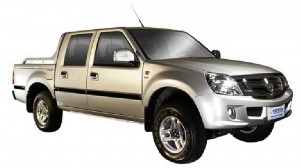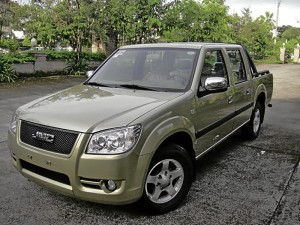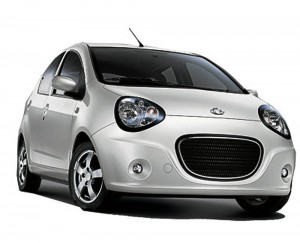Is there a Chinese car in your future?
Don’t laugh. Eight or so years ago, most of us wouldn’t be caught dead driving a Korean car. But now you see Hyundai and Kia SUVs, cars and minivans everywhere, thanks to a quantum leap in quality, technology, performance and design achieved by South Korea’s auto manufacturers. Korean cars have been winning “Car of the Year” awards in the Western world as well as in emerging markets, while topping quality surveys conducted by JD Power & Associates, Consumer Reports and their European counterparts.
The consensus in the global automotive industry is that China will eventually catch up with Japan, like South Korea has done, and then move on to match American and European levels of quality and safety. The only question is when. A Chinese law requiring foreign auto makers to have local partners helps Chinese car manufacturers, via the transfer of expertise and technology, to develop world-class designers, engineers and marketers in pursuit of their Beijing-supported mission to become full-fledged global competitors.
It is in this context that China’s Zheijiang Geely Holding Group acquired Volvo, the Swedish luxury car manufacturer, in 2010 from Ford Motor Co. and why SAIC Motor Corp., General Motors’ Chinese partner since 1997, recently opened North American headquarters near GM’s Detroit base in Michigan. SAIC is prodding GM to share its advanced electric car technology and at the same time wants to set up operations in Latin America and Europe, where GM has long been doing business.
Cooling market.China’s cooling auto market, after years of explosive double-digit growth, is fueling the country’s drive to export and sell cars abroad. Economic growth in China
sputtered to a three-year low of 7.6 percent in the second quarter this year, ballooning unsold car inventories and alarming automakers used to gaining easy profit. The share of passenger vehicle sales held by Chinese brands has fallen to 26 percent from 31 percent in 2010 and 46 percent in 2009, forcing the Chinese to slash prices and offer discounts. They also face intensified competition from foreign auto makers that have begun offering less expensive cars like Nissan Motor’s $10,600 Venucia D50 (basic model.)
Article continues after this advertisementWhat does all this have to do with the Philippine car market? As domestic production glut outruns demand for homegrown vehicles in China, the Philippines joins other emerging markets like Algeria, Brazil, Chile, Iran, Russia and South Africa as a target for export sales. Chery, Geely, Great Wall, Foton, JMC, Chana and Lifan are Chinese brands that have set up business operations here.
Article continues after this advertisementIn 2011, Chinese exports of cars and trucks rose 50 percent from 2010 to 849,500 units, according to the China Association of Automobile Manufacturers. A drop in the bucket compared to the 4.4 million vehicles exported by Japan and the 3.2 million exported by Korea. But Chinese exports are projected to grow at a similar annual pace of 50 percent over the next few years as annual auto sales in developing countries have risen 45 percent since 2005 to 21.3 million cars and light trucks last year. In 2010, with China included, auto sales in emerging markets passed industrialized countries for the first time.
Acceptable. Since Chinese brands in general have a reputation for low quality and safety issues, they are not acceptable in Europe and the United States where consumers expect high standards. However, the low retail prices of Chinese cars, almost half those of Western rivals, make them very marketable in Asia, Latin America and Africa where less affluent buyers purchase them as alternatives to used cars, motorcycles and low-end international models.
This is not to say that Filipino consumers, especially those in Metro Manila and other big cities, are less demanding and less sophisticated about cars than consumers in industrialized countries. But in the rural areas and provinces, people have less access to car reviews in magazines or on the Internet and are more concerned about prices than initial quality and safety ratings. It is in these small towns and farmland areas that extremely affordable Chinese vehicles such as diesel pickup trucks priced at less than P700,000 have a better chance to be sold, especially if the marketing is done by a hometown businessman who has earned the trust of local consumers over the years.
Tested. I have test-driven Chery, Geely, Great Wall, Foton and JMC cars, SUVs, MPVs, minivans and one pickup truck. In Beijing and Shanghai, I have experienced riding Chinese taxicabs. In terms of driving dynamics, design, safety, NVH [noise, vibration and harshness], ride quality and craftsmanship, there is generally much room for improvement, although I found two Chinese cars I test-drove—the Coolbear of Great Wall Motors and the Geely Panda—attractive.
A survey of new car buyers in China conducted by JD Power & Associates last year found that they had reported 232 quality problems for every 100 Chinese-brand cars purchased compared to 131 defects reported for every 100 cars carrying international brands. On the other hand, Jacob George, the managing director of JD Powers’ China division, said that since 2000, Chinese automakers have been steadily closing the gap with their overseas rivals. If trends continue, George predicted that by 2018, Chinese manufacturers would catch up in quality.
2018 is only six years away. If this prediction comes true, you may end up buying a Chinese car after all.
(Sources: The Wall Street Journal, International Herald Tribune and Reuters)


